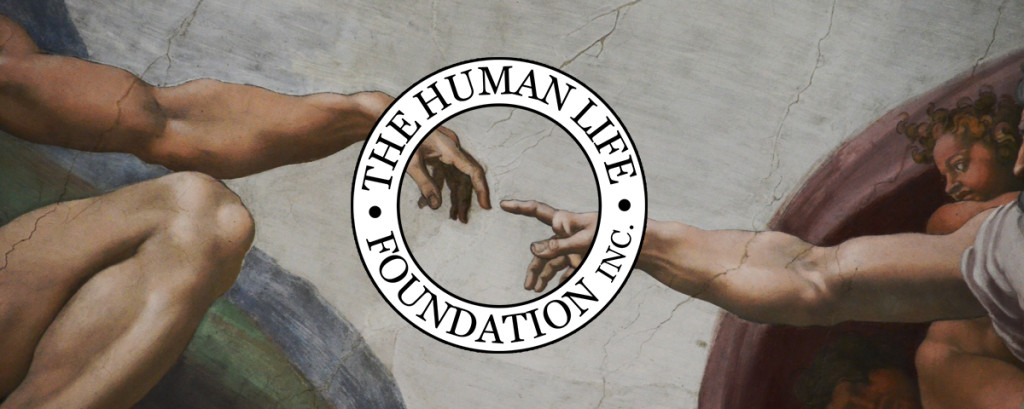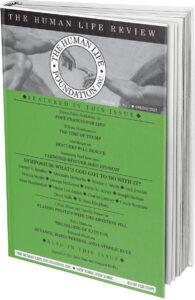What the Abortion Argument Is About
Malcolm Muggeridge was one of Britain’s best-known authors, a prolific writer whose articles and books have achieved international acclaim since the 1930’s, and was also a familiar British television personality. This article originally appeared in the London Sunday Times, and was reprinted in our 1975 issue in slightly abridged form. Mr. Muggeridge was a staunch defender of life and a loyal supporter of the Human Life Review, and we are honored this year to have a special Great Defender of Life Dinner giving level in his name.
Generally, when some drastic readjustment of accepted moral values, such as is involved by legalized abortion, is under consideration, once the decisive legislative step is taken the consequent change in mores soon comes to be more or less accepted, and controversy dies down. This happened, for instance, with the legalization of homosexual practices of consenting adults.
Why, then, has it not happened with the legalization of abortion? Surely because the abortion issue raises questions of the very destiny and purpose of life itself; of whether our human society is to be seen in Christian terms as a family with a loving father who is God, or as a factory-farm whose primary consideration must be the physical wellbeing of the livestock and the material well-being of the collectivity.
This explains why individuals with no very emphatic conscious feelings about abortion one way or the other, react very strongly to particular aspects of it. Thus, nurses who are not anti-abortion zealots cannot bring themselves to participate in abortion operations, though perfectly prepared to take their part in what are ostensibly more gruesome medical experiences.
Again, the practice of using for experiment live fetuses removed from a womb in abortion arouses a sense of horror in nearly everyone quite irrespective of their views on abortion as such.
Why is this, if the fetus is just a lump of jelly, as the pro-abortionists have claimed, and not to be considered a human child until it emerges from its mother’s womb? What does it matter what happens to a lump of jelly? What, for that matter, is the objection to using discarded fetuses in the manufacture of cosmetics—a practice that the most ardent abortionist is liable to find distasteful? We use animal fats for the purpose. Then why not a fetus’s which would otherwise just be thrown away with the rest of the contents of a surgical bucket?
It is on the assumption that a fetus does not become a child until it is actually delivered that the whole case for legalized abortion rests. To destroy a developing fetus in the womb, sometimes as late as seven months after conception, is considered by the pro-abortionists an act of compassion. To destroy the same fetus two months later when it has been born, is, in law, murder—vide Lord Hailsham’s contention that “an embryo which is delivered alive is a human being, and is protected by the law of murder . . . any experiments on it are covered by the law of assault affecting criminal assault on human beings.”
Can it be seriously contended that the mere circumstance of being delivered transforms a developing embryo from a lump of jelly with no rights of any kind, and deserving of no consideration of any kind, into a human being with all the legal rights that go therewith? In the case of a pregnant woman injured in a motor accident, damages can be claimed on behalf of the child in her womb. Similarly, in the UN Declaration of Rights of the Child, special mention is made of its entitlement to pre- as well as post-natal care. It is a strange sort of pre-natal care which permits the removal of the child from its mother’s womb, to be tossed into an incinerator, or used for “research.” or rendered down for cosmetics.
Our Western way of life has come to a parting of the ways; time’s takeover bid for eternity has reached the point at which irrevocable decisions have to be taken. Either we go on with the process of shaping our own destiny without reference to any higher being than Man, deciding ourselves how many children shall be born, when and in what varieties, which lives are worth continuing and which should be put out, from whom spare-parts-kidneys, hearts, genitals, brainboxes even-shall be taken and to whom allotted.
Or we draw back, seeking to understand and fall in with our Creator’s purpose for us rather than to pursue our own; in true humility praying, as the founder of our religion and our civilization taught us: Thy will be done.
This is what the abortion controversy is about, and what the euthanasia controversy will be about when, as must inevitably happen soon, it arises. The logical sequel to the destruction of what are called “unwanted children” will be the elimination of what will be called “unwanted lives”—a legislative measure which so far in all human history only the Nazi Government has ventured to enact.
In this sense the abortion controversy is the most vital and relevant of all. For we can survive energy crises, inflation, wars, revolutions and insurrections, as they have been survived in the past; but if we transgress against the very basis of our mortal existence, becoming our own gods in our own universe, then we shall surely and deservedly perish from the earth.









